
THERE’S no question that 2015 was a bumper year for new four-wheel drive releases. It was one of the best in memory and brought us a new Toyota Hilux, Toyota Fortuna, Ford Everest, Mitsubishi Pajero Sport and Triton, and a swag of upgraded models.
While those new vehicles excite those folks looking to update their 4x4s, for those in the aftermarket accessories industry it means a whole lot of work researching and developing products to suit all the new vehicles and variants.
For a company like Ironman 4x4, an influx of new models means massive investment. Those bullbars and suspension packages don’t get delivered by Santa Claus but require vehicles to be bought and thousands of hours of development before the first prototypes are even fitted to a car.
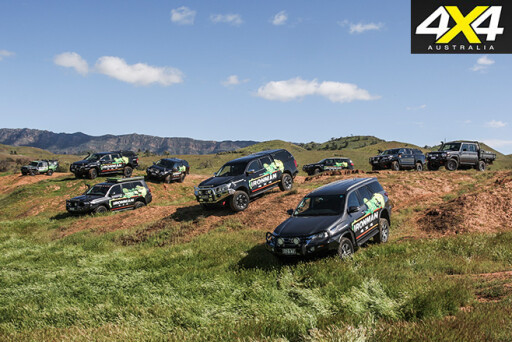 Toward the end of 2005, when we were visiting Ironman 4x4’s Melbourne head office, Adam Craze invited us out to the back shed as he had something to show us. Behind the big roller door were no less than 12 new vehicles, most shining in the company’s signature black, but there were a few graphite grey Toyotas in there too.
Toward the end of 2005, when we were visiting Ironman 4x4’s Melbourne head office, Adam Craze invited us out to the back shed as he had something to show us. Behind the big roller door were no less than 12 new vehicles, most shining in the company’s signature black, but there were a few graphite grey Toyotas in there too.
These vehicles represented a massive investment for Ironman 4x4 and the workload Adam and his team had ahead of them. There was around $600,000 in purchases alone, but when you add the research and development that goes into them you can double that figure. Buying the 4x4s is just the beginning.
Vehicles like the new Everest and Fortuna required all-new product, created from scratch to suit the new body styles. But even the updated vehicles, such as the facelifted Land Cruiser 200 Series, needed new or updated products. New technology including the forward collision system and radar cruise control that came with updates (like the PXII Ranger) needed heavily revised bars to accommodate the electronics; while unseen items such as relocated parts in the engine bay of the 200 Series needed revisions to things like auxiliary battery systems.
 It all meant a lot of work for Ironman 4x4 (and other 4x4 accessory companies) in order to stay at the top of the game and be able to supply equipment as soon as possible once the vehicles are on sale.
It all meant a lot of work for Ironman 4x4 (and other 4x4 accessory companies) in order to stay at the top of the game and be able to supply equipment as soon as possible once the vehicles are on sale.
The work doesn’t finish once the product has been designed, engineered and manufactured. There’s still product information to be produced for the retail stores, and packaging, promotions and marketing to let the customers know that the latest gear is available for their new 4x4 purchase.
We’ve all seen Ironman 4x4’s impressive photos of fully loaded vehicles in stunning locations and wondered just how to get a job with those guys. So when Adam invited us to join an Ironman 4x4 convoy to the Flinders Ranges to shoot the latest vehicles, he didn’t have to ask twice.
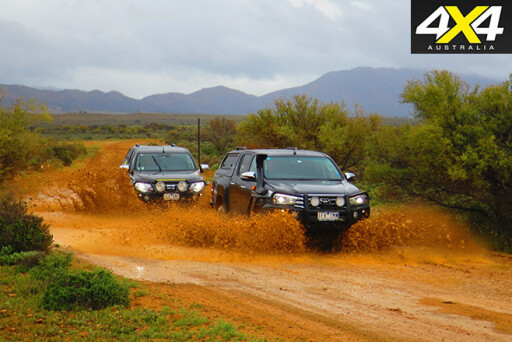 Touring some of the Flinders’ best-known locations during spring with a team of fully equipped 4x4s was an opportunity too good to pass up, even if it meant a pre-dawn start out of Melbourne in order to reach the Flinders on Day One.
Touring some of the Flinders’ best-known locations during spring with a team of fully equipped 4x4s was an opportunity too good to pass up, even if it meant a pre-dawn start out of Melbourne in order to reach the Flinders on Day One.
The convoy included an Everest Trend, Ranger XLT, Hilux SR, Fortuna, Triton, LC200, Navara D23 and a pair of LC79 utes. While most of what you can see on the cars was production-ready product that is available to the consumer, some were fitted with prototype parts undergoing development for future additions to the Ironman catalogue.
GET OUT OF TOWN
THE long day on sealed roads to get out of town meant we would have the five days to explore the Flinders. And at the end that tiring first day we were rewarded with a stay at the historic Cradock Hotel. Cradock is at the southern end of the Flinders, and the pub there is more than 120 years old.
Thankfully it has been renovated a few times since the 1880s but it still offers an historic feeling, with welcoming publicans, good accommodation, great meals and cold beer. It’s definitely worth the time if you’re looking for a place to stop on your Flinders adventure.
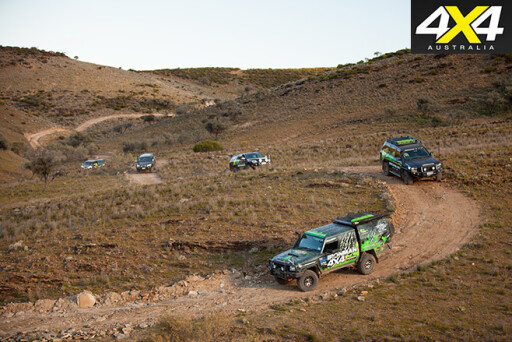 The following days were spent enjoying the best of the Flinders. After fuelling up in Hawker we toured the scenic drive through the Arkaba Conservation Sanctuary which was once a grazing property but is slowly being returned to its native state through the efforts of Wild Bush Luxury, the property owners. It’s interesting to see how the land on this property differs from the surrounding grazing properties since it was taken over back in 2009.
The following days were spent enjoying the best of the Flinders. After fuelling up in Hawker we toured the scenic drive through the Arkaba Conservation Sanctuary which was once a grazing property but is slowly being returned to its native state through the efforts of Wild Bush Luxury, the property owners. It’s interesting to see how the land on this property differs from the surrounding grazing properties since it was taken over back in 2009.
The drive through the property is not off-road, but it takes you through rolling hills and craggy gorges typical of the area. It wasn’t real off-road, but it was good to get the Ironman convoy off the bitumen and into the dust.
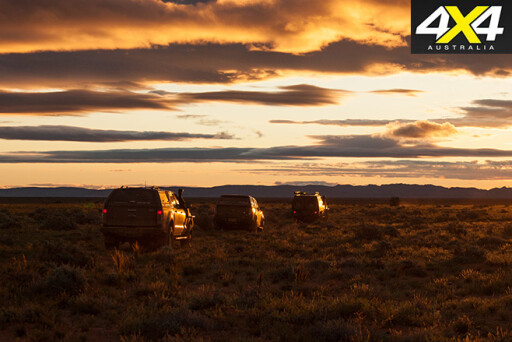 Another gorge run further north took us through the spectacular Parachilna Gorge so that we could loop around and get back to our camp at Wilpena Pound for the next few nights. Along the way we stopped at various points to snap the vehicles in this spectacular part of the country.
Another gorge run further north took us through the spectacular Parachilna Gorge so that we could loop around and get back to our camp at Wilpena Pound for the next few nights. Along the way we stopped at various points to snap the vehicles in this spectacular part of the country.
More gorging the next day, this time through Bunyeroo and Brachina Gorges that each supplied stunning backdrops for photos and video. It was while returning from Brachina that the clouds formed and promised rain, and light showers overnight put a dampener on our Wilpena campsite.
With the same weather front that was playing havoc with the Icons trip (see page 120) now hovering over us, we decided to head east where the maps said there was less rain. Back roads took us to more open country where we were able to vary the style of shots and videos we were getting of the vehicles. The rain was scattered but the roads remained solid.
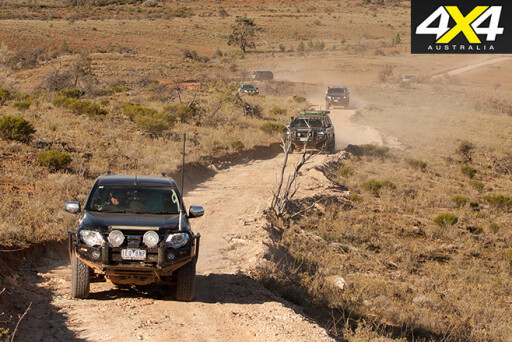 Arriving at Lake Frome right on sunset was well worth the drive, as the colours and textures of the surrounding dunes and hills came alive. It was the ideal time to put up the drone to capture the true remoteness of the area.
Arriving at Lake Frome right on sunset was well worth the drive, as the colours and textures of the surrounding dunes and hills came alive. It was the ideal time to put up the drone to capture the true remoteness of the area.
Backtracking in the dark gave us all a chance to check out the performance of Ironman’s new range of LED lights. The vehicles were equipped with both round and light bar LEDs, and they were invaluable for spotting wildlife and variations in road conditions.
We got back to Blinman with some of the vehicles running on fumes, only to find we were too late for both the pub and the fuel pumps. So, after putting one of the cars on the back of a strap, it was a slow run back down to Wilpena.
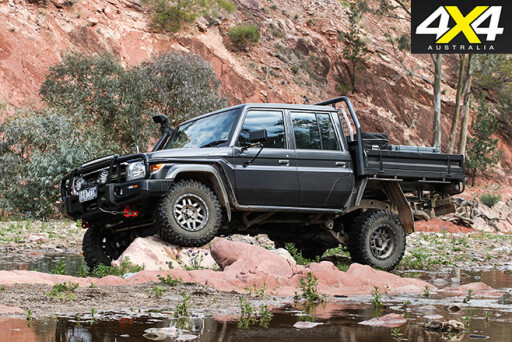 Daybreak saw the sun out and the group rolling up wet swags. We were moving across the road to Willow Springs and its impressive Skytrek scenic drive. We found a campsite that could accommodate our group and unloaded some gear before we set off on the 80km loop around the property. We just made the 10.30am cut-off, so we were the last group on the track. This gave us time to stop and shoot as needed.
Daybreak saw the sun out and the group rolling up wet swags. We were moving across the road to Willow Springs and its impressive Skytrek scenic drive. We found a campsite that could accommodate our group and unloaded some gear before we set off on the 80km loop around the property. We just made the 10.30am cut-off, so we were the last group on the track. This gave us time to stop and shoot as needed.
When you sign up to do Skytrek you get a leaflet that contains notes on where you are going and what you can expect to see along the way. There are 50 points of interest marked along the route and, provided you reset your trip meter at the start gate, you can follow the points in the trip notes. Willow Springs recommends allowing around six hours for the trek, which is why they have a cut-off start time.
We were lucky to get a break in the weather, as the drive around Skytrek is truly spectacular. One minute you’re driving through valleys with towering mountains either side of the track; the next you’re passing through dry creek beds that form tight gorges leading to open plains. It’s not until you reach the last quarter of the trek that you find out why Skytrek gets its name.
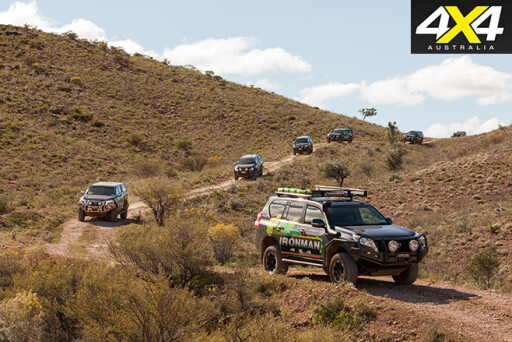 The track climbs steeply and requires low range, as some of the surface is loose and scrabbly. Reaching it late in the afternoon, as we did, you look straight up in to the setting sun; but once you reach the summit, you feel as if you’ve reached the sky. Time it right, and with some co-operative clouds, and you’ll be treated to a spectacular Flinders sunset over the peaks of Wilpena Pound to the west.
The track climbs steeply and requires low range, as some of the surface is loose and scrabbly. Reaching it late in the afternoon, as we did, you look straight up in to the setting sun; but once you reach the summit, you feel as if you’ve reached the sky. Time it right, and with some co-operative clouds, and you’ll be treated to a spectacular Flinders sunset over the peaks of Wilpena Pound to the west.
It was a fitting way to end our Flinders trek and we celebrated around the campfire that night. For some in the group it had been their first 4x4 experience, and these are the moments to remember! But the fun driving wasn’t over yet.
No one was looking forward to the long highway drive back to Melbourne, so Adam and Smithy from Ironman 4x4 found a more interesting route. We followed the dirt roads east of Hawker, out through Waukaringa and its abandoned goldfields, before meeting the Barrier Highway at Yunta. From here the Queenslanders in the group split north toward Broken Hill while the rest of the convoy crossed the highway and continued south on the dirt through the Danggali Conservation Reserve.
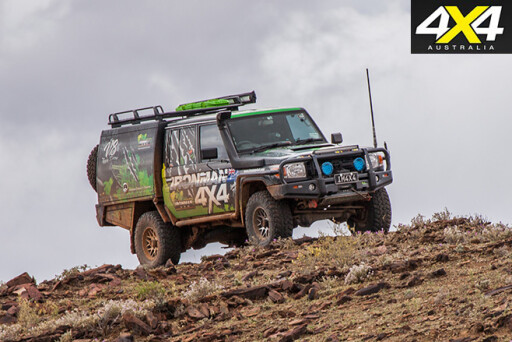 While this was a more interesting drive than the highway, storm clouds gathered as the sun set and another weather front caught up with us. Heavy rain turned the road to soapy mud and there were many sections that had to be bypassed; others sections required you to stab the throttle and attempt to keep the wheels pointed where you needed to go. It made for a long but exciting drive, and it’s a short cut we’d like to cover during the light of day.
While this was a more interesting drive than the highway, storm clouds gathered as the sun set and another weather front caught up with us. Heavy rain turned the road to soapy mud and there were many sections that had to be bypassed; others sections required you to stab the throttle and attempt to keep the wheels pointed where you needed to go. It made for a long but exciting drive, and it’s a short cut we’d like to cover during the light of day.
It was after midnight when the eight very muddy Ironman 4x4s rolled in to a motel carpark in Wentworth, New South Wales, but we found the stamina to enjoy some carpark ales to mark the end of the adventure. That last drive had been gruelling for some and those beers went down very nicely. The warm, dry bed was much appreciated as well.
It had been a hectic schedule, but we covered challenging terrain, saw spectacular scenery and really put the vehicles, drivers and Ironman 4x4 gear to the test. The only equipment failure was a single flat tyre on one of the two cars in the convoy not wearing Mickey Thompson rubber. The rocky tracks had been harsh on tyres, but the Mickeys showed no signs of the torture they were subjected to.
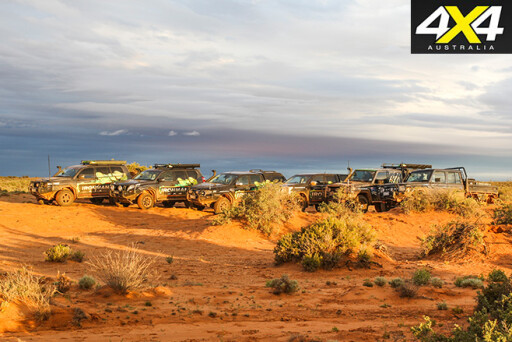 The next time you’re looking through the Ironman 4x4 catalogues or website and you’re taken aback by some of the stunning images, check to see if it was one of these cars and if the images look familiar.
The next time you’re looking through the Ironman 4x4 catalogues or website and you’re taken aback by some of the stunning images, check to see if it was one of these cars and if the images look familiar.
You’ll know where they were taken and you’ll have an appreciation of the work required to capture them. It might also make you think about what goes in to making Ironman 4x4’s quality products for your 4x4 vehicle.
Watch the video of Ironman 4X4's Flinders Adventure.



COMMENTS